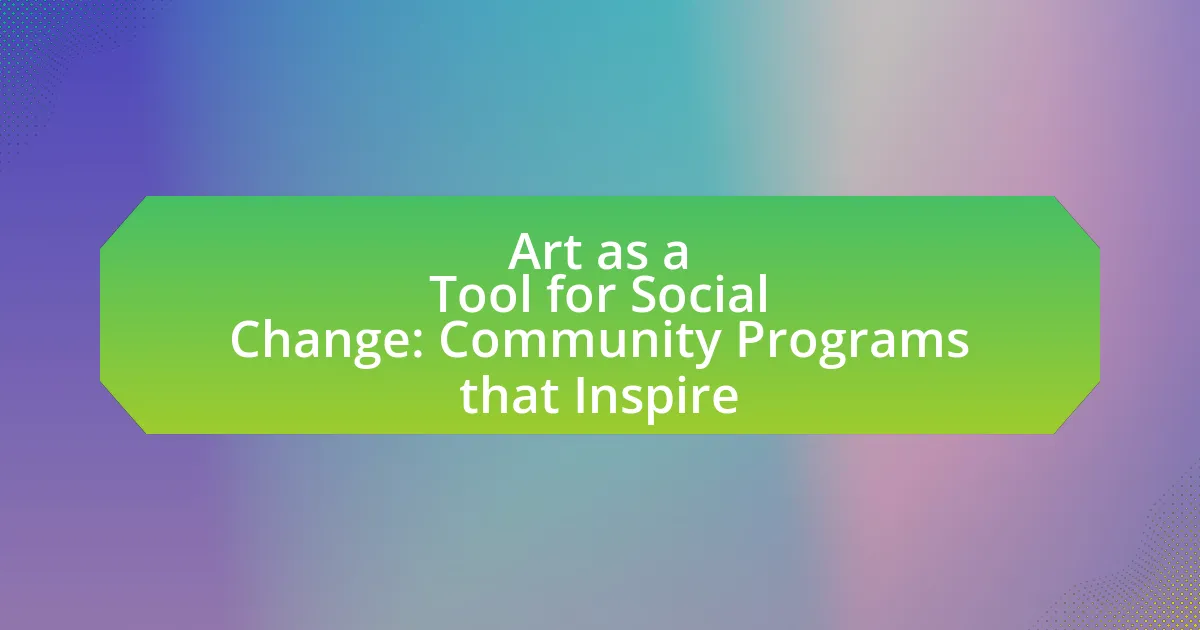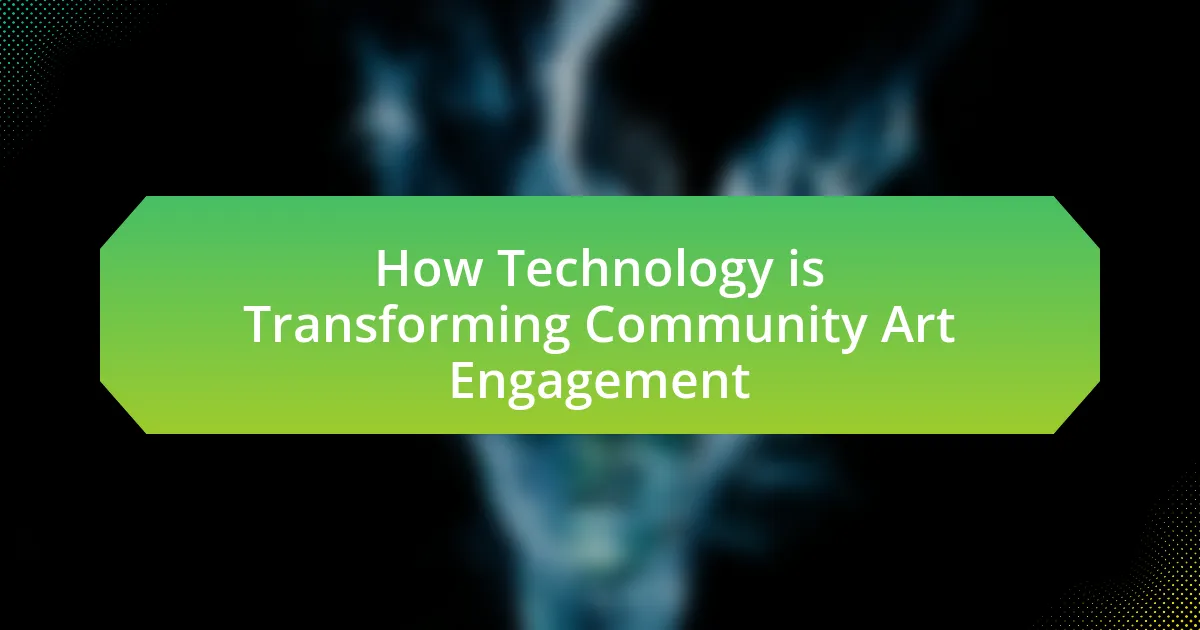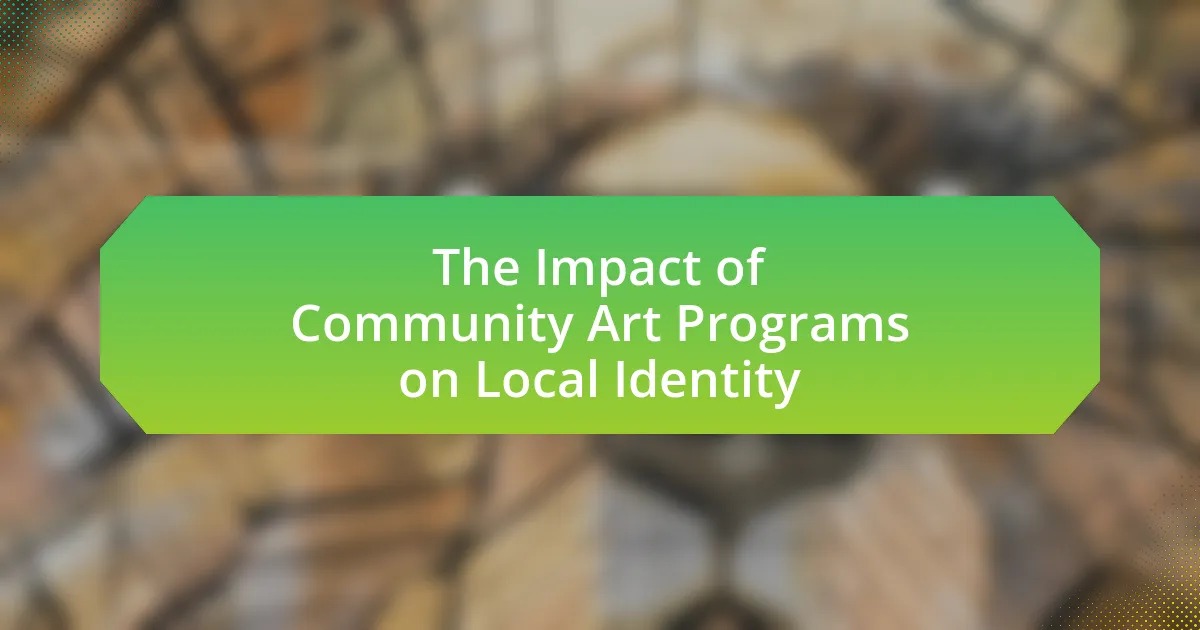Community art projects are collaborative initiatives that engage local residents in creating art, enhancing community identity and social cohesion. This article explores various successful case studies of community art projects, highlighting their characteristics, importance, and the impact they have on local communities. Key topics include the differences between community art projects and traditional art initiatives, the types of projects that exist, and the measurable outcomes of successful initiatives. Additionally, the article discusses best practices for fostering community participation and collaboration, as well as common pitfalls to avoid in future projects.
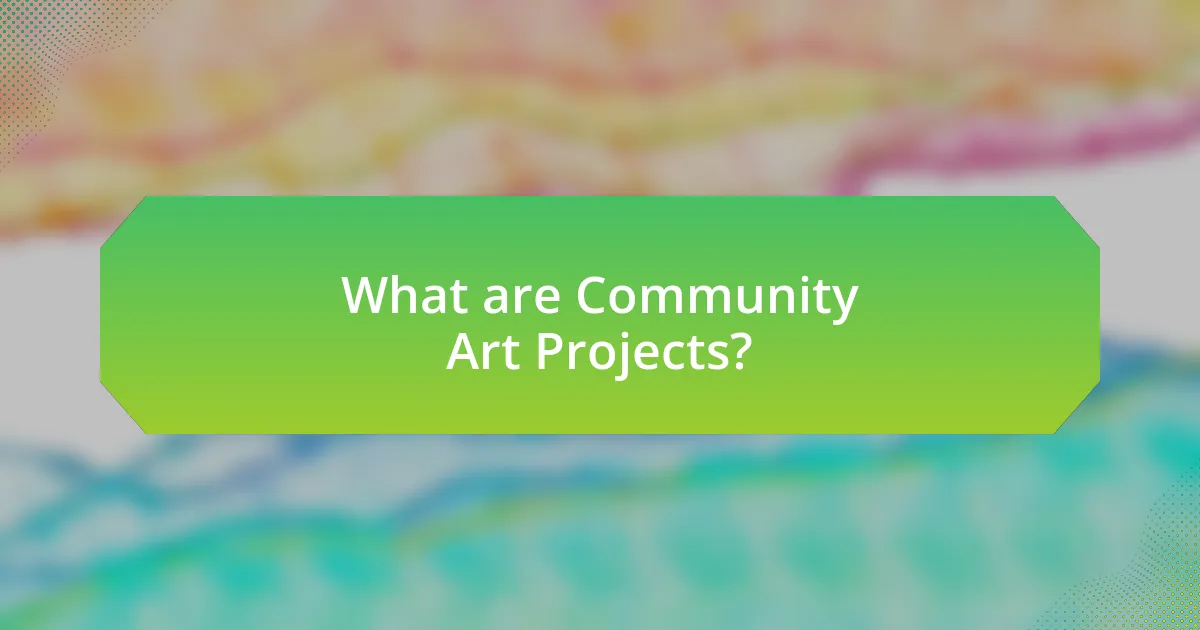
What are Community Art Projects?
Community art projects are collaborative initiatives that engage local residents in the creation of art, fostering community identity and social cohesion. These projects often involve various forms of artistic expression, such as murals, sculptures, performances, and workshops, aimed at addressing community issues or celebrating local culture. Research indicates that community art projects can enhance social capital, improve mental health, and promote civic engagement, as evidenced by studies showing increased community participation and satisfaction in areas where such projects are implemented.
How do Community Art Projects differ from traditional art initiatives?
Community art projects differ from traditional art initiatives primarily in their focus on collaboration and community engagement. While traditional art initiatives often center around individual artists and their personal expressions, community art projects emphasize collective participation, aiming to involve local residents in the creation process. This participatory approach fosters a sense of ownership and connection to the artwork, as seen in projects like the “Chicago Mural Project,” where community members collaborated with artists to reflect their shared experiences and cultural identities. Such initiatives not only enhance social cohesion but also empower individuals by giving them a platform to express their voices, contrasting with the often top-down nature of traditional art initiatives that may not prioritize community input.
What are the key characteristics of Community Art Projects?
Community Art Projects are characterized by their focus on collaboration, inclusivity, and community engagement. These projects often involve local residents in the creation process, fostering a sense of ownership and pride in the artwork. Additionally, they aim to address social issues or reflect the community’s identity, enhancing cultural awareness and cohesion. Research indicates that such projects can lead to increased social capital and improved community well-being, as evidenced by studies showing that participation in community art initiatives can reduce feelings of isolation and promote social interaction among diverse groups.
Why are Community Art Projects important for local communities?
Community art projects are important for local communities because they foster social cohesion and enhance community identity. These projects encourage collaboration among residents, allowing them to express their cultural narratives and shared values through artistic mediums. Research indicates that community art initiatives can lead to increased civic engagement, as evidenced by a study published in the Journal of Community Engagement and Scholarship, which found that neighborhoods with active art projects reported a 30% increase in community participation and volunteerism. Additionally, these projects can stimulate local economies by attracting visitors and promoting local businesses, further solidifying their significance in community development.
What types of Community Art Projects exist?
Community art projects can be categorized into several types, including mural projects, public art installations, community gardens, performance art, and collaborative workshops. Mural projects involve local artists creating large-scale artworks on public walls, often reflecting community identity or history. Public art installations can include sculptures or interactive pieces placed in communal spaces, enhancing the environment and engaging the public. Community gardens promote environmental awareness and provide a space for residents to cultivate plants together. Performance art projects often involve local talent showcasing their skills in public spaces, fostering community engagement through live events. Collaborative workshops allow community members to participate in the creative process, learning new skills while contributing to a collective artwork. Each type of project serves to strengthen community bonds and promote cultural expression.
How do mural projects contribute to community identity?
Mural projects contribute to community identity by visually representing the shared values, history, and culture of a community. These large-scale artworks often depict local stories, significant figures, or cultural symbols, fostering a sense of belonging among residents. For instance, a study by the University of California, Los Angeles, found that neighborhoods with murals reported higher levels of community pride and engagement, as the murals serve as a focal point for community gatherings and discussions. Additionally, murals can attract tourism, further embedding the community’s identity in the broader cultural landscape.
What role do performance art projects play in community engagement?
Performance art projects serve as vital tools for community engagement by fostering social interaction and cultural expression. These projects create platforms for individuals to share their stories, experiences, and perspectives, thereby enhancing community cohesion. For instance, studies have shown that performance art can increase participation in local events and encourage collaboration among diverse groups, leading to a stronger sense of belonging. Research conducted by the National Endowment for the Arts highlights that communities involved in performance art initiatives report higher levels of civic engagement and social capital, demonstrating the significant impact these projects have on uniting individuals and promoting dialogue within the community.
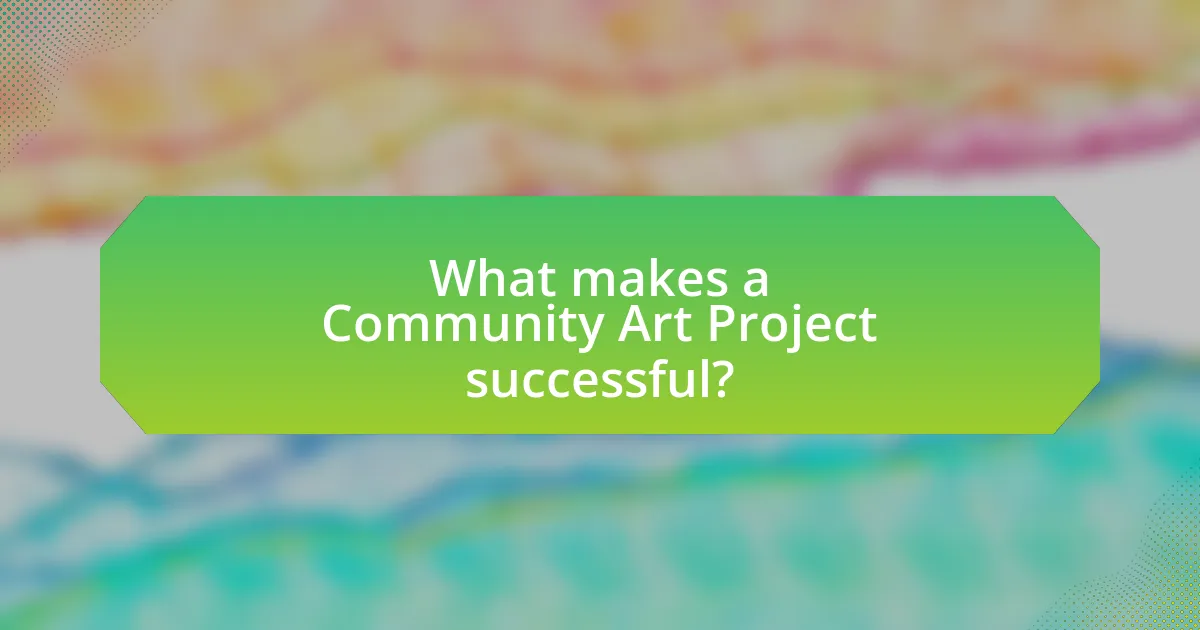
What makes a Community Art Project successful?
A successful Community Art Project is characterized by active community engagement, clear objectives, and collaboration among diverse stakeholders. Active community engagement ensures that the project reflects the interests and needs of the participants, fostering a sense of ownership and pride. Clear objectives provide direction and measurable outcomes, which help in assessing the project’s impact. Collaboration among diverse stakeholders, including artists, community members, and local organizations, enhances resources and expertise, leading to a richer artistic experience. Research indicates that projects with these elements tend to achieve higher levels of participation and satisfaction, as seen in case studies like the “Chicago Public Art Program,” which successfully integrated community input into its initiatives, resulting in increased community cohesion and artistic expression.
How do community involvement and collaboration impact success?
Community involvement and collaboration significantly enhance the success of projects by fostering a sense of ownership and shared purpose among participants. When individuals actively engage in a project, they contribute diverse perspectives and skills, which can lead to more innovative solutions and a stronger commitment to the project’s goals. For instance, a study by the National Endowment for the Arts found that community-driven art projects often result in higher participation rates and greater sustainability compared to those initiated without community input. This evidence illustrates that collaborative efforts not only improve the quality of the outcomes but also build lasting relationships and networks that support future initiatives.
What strategies can be employed to foster community participation?
To foster community participation, strategies such as inclusive planning, collaborative projects, and effective communication can be employed. Inclusive planning involves engaging diverse community members in the decision-making process, ensuring that various perspectives are represented. Collaborative projects, where community members work together on art initiatives, enhance ownership and investment in the outcomes. Effective communication, utilizing multiple channels to disseminate information and gather feedback, ensures that community members feel informed and valued. Research indicates that communities with high levels of participation in local projects report increased social cohesion and satisfaction, demonstrating the effectiveness of these strategies.
How does collaboration with local organizations enhance project outcomes?
Collaboration with local organizations enhances project outcomes by leveraging their established community trust and resources. Local organizations possess in-depth knowledge of community needs and dynamics, which allows projects to be tailored effectively, increasing engagement and participation. For instance, a study by the National Endowment for the Arts found that community-based art projects that partnered with local organizations saw a 30% increase in participation compared to those that did not collaborate. This partnership not only fosters a sense of ownership among community members but also ensures sustainability and relevance of the project, ultimately leading to more impactful and successful outcomes.
What are the measurable outcomes of successful Community Art Projects?
Successful Community Art Projects yield measurable outcomes such as increased community engagement, enhanced social cohesion, and improved mental well-being among participants. For instance, a study by the Arts Council England found that 70% of participants in community art initiatives reported feeling more connected to their community. Additionally, projects often lead to tangible improvements in public spaces, as evidenced by the transformation of neglected areas into vibrant community hubs, which can be quantified through increased foot traffic and local business revenue. Furthermore, surveys conducted post-project frequently indicate a rise in participants’ self-esteem and creativity, with 65% of respondents in a community arts program reporting enhanced personal expression and confidence.
How can we assess the social impact of these projects?
To assess the social impact of community art projects, one can utilize a combination of qualitative and quantitative evaluation methods. Qualitative methods include interviews and focus groups with participants and community members to gather personal experiences and perceptions, while quantitative methods involve surveys and statistical analysis of participation rates, demographic changes, and economic indicators. For instance, a study by the National Endowment for the Arts found that community art projects can lead to increased social cohesion, as evidenced by a 20% rise in community engagement metrics following project implementation. This dual approach provides a comprehensive understanding of the social impact, allowing for the measurement of both subjective experiences and objective outcomes.
What indicators show improvement in community cohesion through art?
Indicators that show improvement in community cohesion through art include increased participation in community events, enhanced social interactions among diverse groups, and positive changes in community perceptions. For instance, studies have shown that community art projects lead to higher attendance at local events, fostering a sense of belonging and shared identity. Additionally, surveys often reveal that participants report stronger relationships with neighbors and a greater willingness to collaborate on community issues. Research conducted by the Arts Council England indicates that 78% of participants in community art initiatives felt more connected to their community, demonstrating the tangible impact of art on social cohesion.
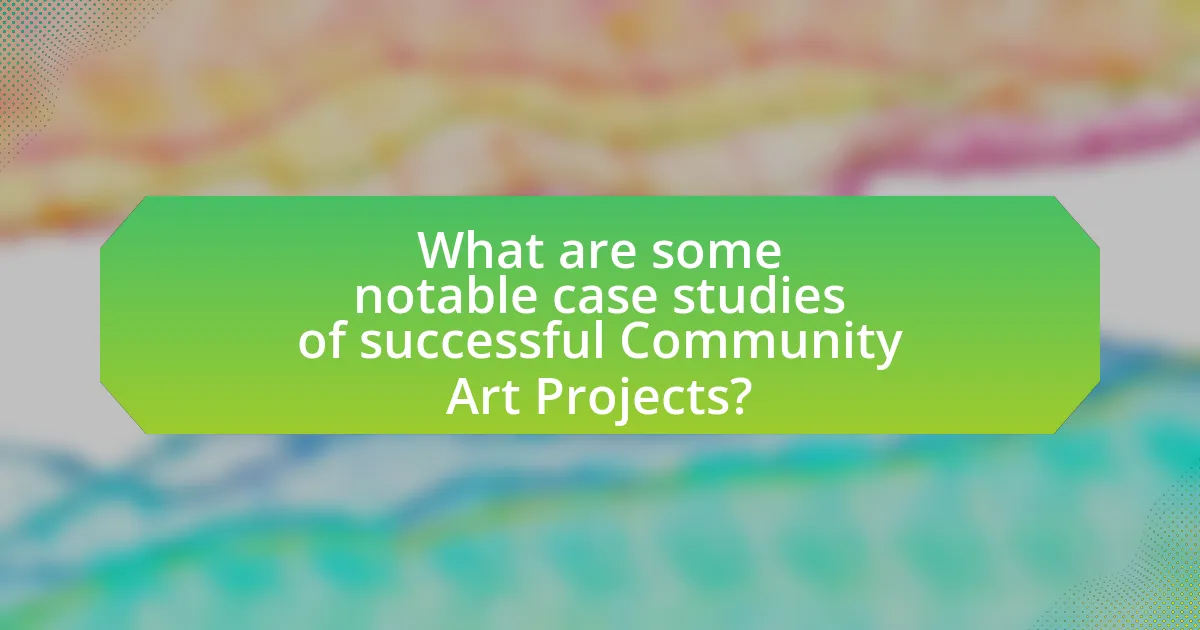
What are some notable case studies of successful Community Art Projects?
Notable case studies of successful Community Art Projects include the “Chicago Mural Project,” which transformed neglected urban spaces into vibrant murals, fostering community pride and engagement. This project involved local artists and residents, resulting in over 100 murals that reflect the community’s identity and history. Another example is the “The People’s Palace” in Glasgow, which utilized art to address social issues, engaging diverse community members in the creation of art that represents their experiences and aspirations. This initiative not only beautified the area but also sparked conversations around social justice and community cohesion. Additionally, the “Art on the Streets” project in San Francisco successfully integrated art into public spaces, involving local artists and residents in the design process, which led to increased foot traffic and revitalization of the neighborhood. These case studies demonstrate the power of community art projects to enhance local culture, foster collaboration, and address social issues.
How did the “Community Mural Project” transform a neighborhood?
The “Community Mural Project” transformed a neighborhood by enhancing its visual appeal and fostering community engagement. The project involved local artists and residents collaborating to create murals that reflected the neighborhood’s culture and history, which not only beautified public spaces but also instilled a sense of pride among residents. Studies have shown that such community art initiatives can lead to increased social cohesion, reduced crime rates, and improved local economies, as evidenced by the positive outcomes observed in neighborhoods that implemented similar projects.
What challenges were faced during the “Community Mural Project”?
The “Community Mural Project” faced several challenges, including securing funding, engaging community members, and managing differing artistic visions. Funding was a significant hurdle, as the project relied on grants and donations to cover materials and labor costs. Engaging community members proved difficult due to varying levels of interest and participation, which impacted the project’s inclusivity. Additionally, the project encountered conflicts arising from differing artistic visions among participants, necessitating compromise and collaboration to achieve a cohesive final mural. These challenges highlight the complexities involved in executing community art initiatives.
What lasting effects did the “Community Mural Project” have on residents?
The “Community Mural Project” had lasting effects on residents by fostering a sense of community pride and ownership. Residents reported increased social cohesion and engagement, as the project brought together diverse groups to collaborate on a shared artistic vision. Additionally, the murals served as a visual representation of local culture and history, enhancing the neighborhood’s identity. Studies indicate that such community art initiatives can lead to improved mental well-being and reduced crime rates, as seen in similar projects across various cities.
What lessons can be learned from the “Public Art Initiative”?
The “Public Art Initiative” teaches the importance of community engagement in the creation of public art. Successful projects demonstrate that involving local residents in the planning and execution fosters a sense of ownership and pride, which enhances the artwork’s impact. For instance, studies show that public art projects with community input lead to higher levels of public satisfaction and increased foot traffic in the area, as evidenced by the revitalization of neighborhoods in cities like Philadelphia and Chicago. These examples highlight that collaboration between artists, local governments, and community members is crucial for the sustainability and relevance of public art.
How did the “Public Art Initiative” engage diverse community members?
The “Public Art Initiative” engaged diverse community members by facilitating collaborative art projects that included input from various cultural, socioeconomic, and age groups. This approach ensured that the artwork reflected the community’s collective identity and values, fostering a sense of ownership and pride among participants. For instance, the initiative organized workshops and public forums where residents could share their ideas and contribute to the design process, resulting in art that resonated with the local population. Additionally, partnerships with local organizations helped to reach underrepresented groups, ensuring inclusivity in participation and representation.
What innovative approaches were used in the “Public Art Initiative”?
The “Public Art Initiative” employed innovative approaches such as community engagement, collaborative design processes, and the integration of technology in art installations. Community engagement involved local residents in the planning and execution stages, ensuring that the art reflected the community’s identity and values. Collaborative design processes brought together artists, architects, and community members to co-create artworks, fostering a sense of ownership and pride. Additionally, the initiative utilized technology, such as augmented reality and interactive installations, to enhance viewer experience and accessibility, making art more engaging and relevant to diverse audiences. These approaches have been documented in various case studies, highlighting their effectiveness in revitalizing public spaces and strengthening community ties.
What best practices can be derived from these case studies?
Best practices derived from case studies of successful community art projects include fostering collaboration among diverse stakeholders, ensuring community involvement in the planning and execution phases, and prioritizing sustainability in project design. Collaboration enhances resource sharing and expertise, as seen in projects where local artists partnered with community organizations, leading to increased engagement and support. Community involvement ensures that the art reflects local culture and needs, which has been shown to boost participation and ownership, as evidenced by projects that incorporated feedback from residents during development. Sustainability in design not only addresses environmental concerns but also ensures the longevity of the art, with successful projects often incorporating durable materials and ongoing maintenance plans, thereby creating lasting community assets.
How can future Community Art Projects incorporate these best practices?
Future Community Art Projects can incorporate best practices by actively engaging local stakeholders in the planning and execution phases. This approach ensures that the projects reflect the community’s needs and values, fostering a sense of ownership and participation. For instance, successful projects like the “Chicago Mural Project” involved community members in the design process, resulting in artwork that resonated with local culture and history. Research indicates that community involvement increases project sustainability and enhances social cohesion, as evidenced by studies showing that participatory art initiatives lead to higher community satisfaction and engagement levels.
What common pitfalls should be avoided in Community Art Projects?
Common pitfalls to avoid in Community Art Projects include lack of community engagement, insufficient planning, and inadequate funding. Lack of community engagement can lead to projects that do not reflect the interests or needs of the community, resulting in low participation and impact. Insufficient planning often results in unclear objectives and timelines, which can derail the project. Inadequate funding can limit resources, leading to compromised quality and sustainability of the art project. According to a study by the National Endowment for the Arts, successful community art projects prioritize community involvement and thorough planning to ensure relevance and longevity.



